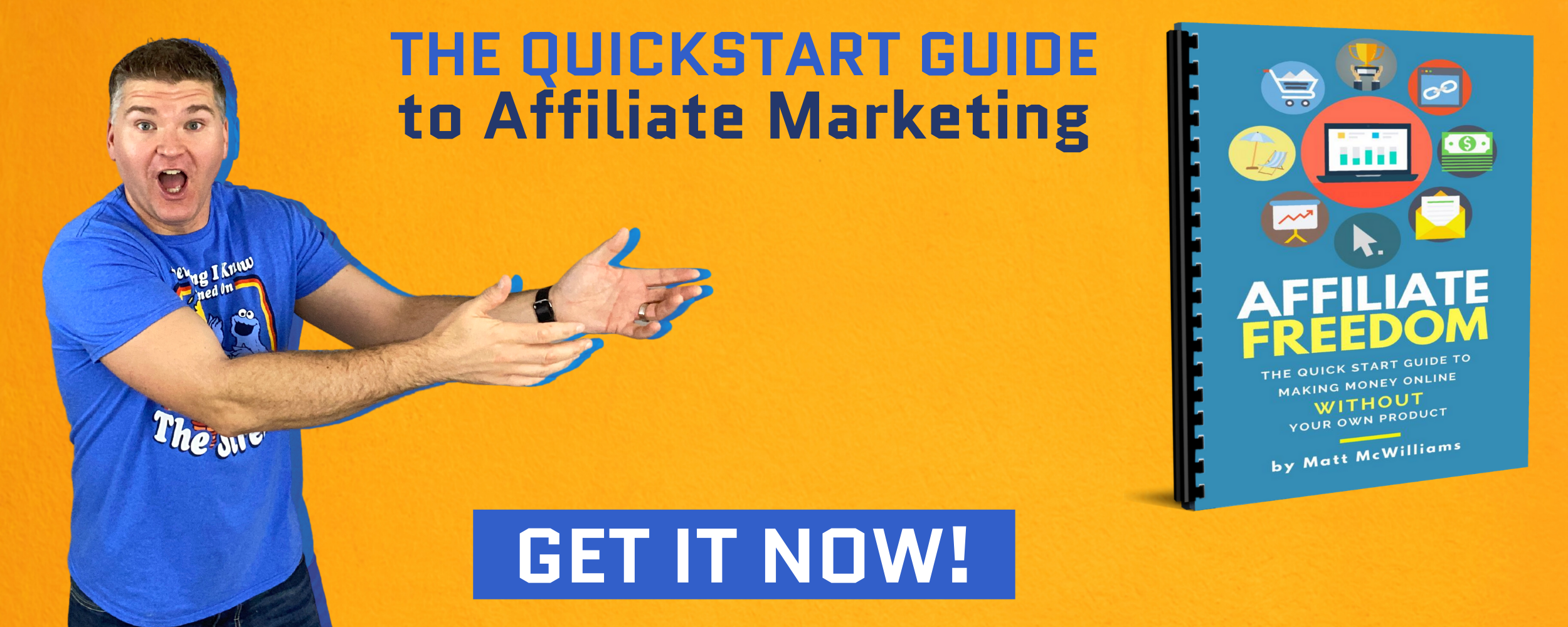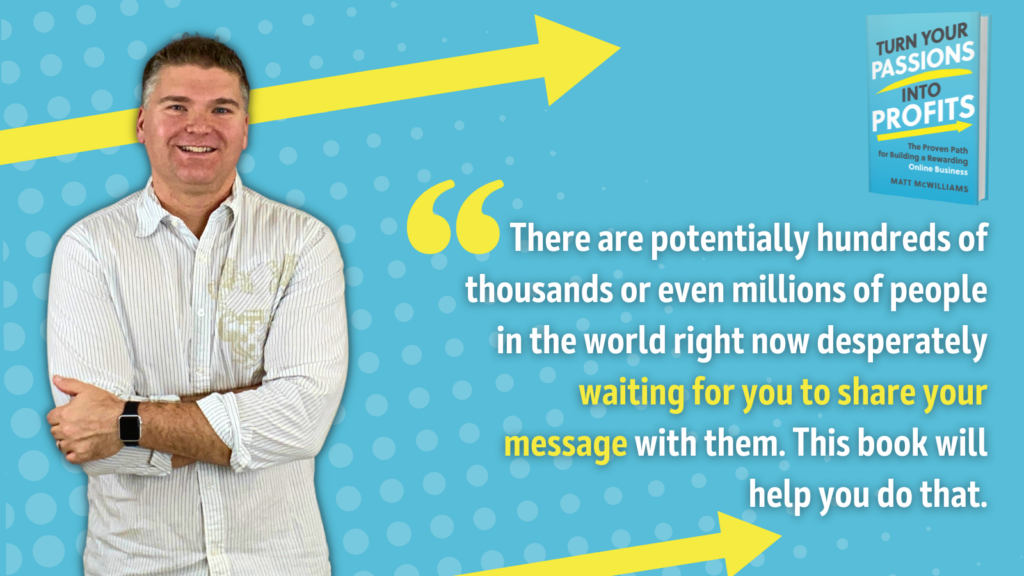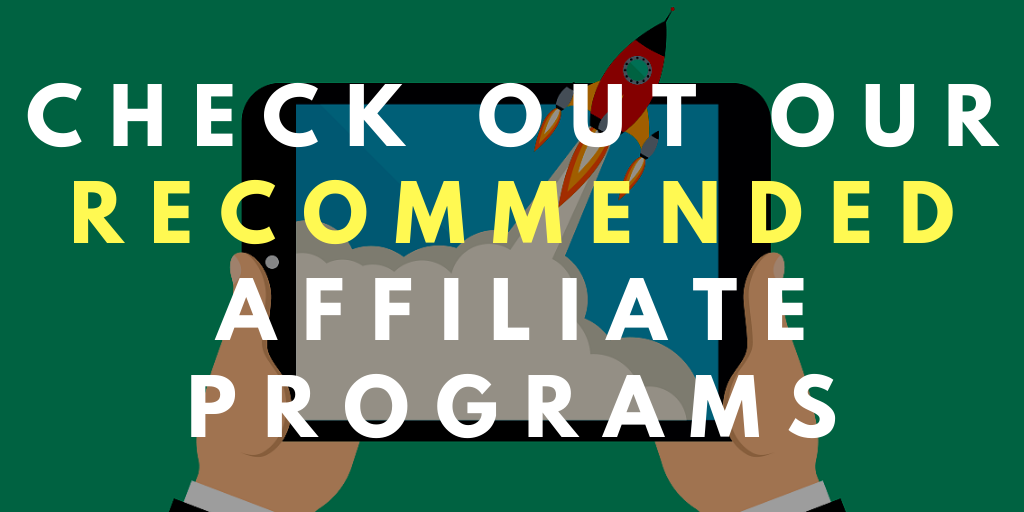I’m so excited about today’s episode because I finally get to introduce you to someone who has made a huge impact on my business. If you want to learn how to connect with potential affiliate partners, clients, and VIPs in your industry, today’s episode is for you!
Click Here for The Written Transcript of This Episode
Links Mentioned in this Episode
Text Me: (260) 217-4619
Don’t Miss An Episode – Subscribe Below
Previous Episodes of The Affiliate Guy
How to Use Pinterest for Affiliate Marketing
10 Ways to Get Your Affiliates Fired Up Before a Launch or Promo
How to Provide Great Swipe Copy for Your Affiliate Program
The Dark Side of Entrepreneurship: Overcoming Setbacks, Pain, Fatigue, and Failure
7 Reasons Why Entrepreneurs Live Longer
Lessons Learned from a Multi-Million Dollar Affiliate Launch
The Power of the Dream 100 with Dana Derricks
I’m so excited about today’s episode because I finally get to introduce you to someone who has made a huge impact on my business.
If you want to learn how to connect with potential affiliate partners, clients and VIPs in your industry, today’s episode is for you.
So, like I said, I am so excited about this episode because I get to introduce you to my friend Dana Derricks. Dana is somebody that I’ve known and followed for quite some time, but really got to develop a relationship with him and a friendship with him just over the last couple of months.
He’s somebody that is going to be instrumental in our growth as a company, and he solved a big problem for us, particularly with how to manage affiliate relationships and relationships in general, and we’re going to talk about that in today’s episode.
What he’s done for us, it’s awesome. And I am so excited not only about what he’s already done, and to be quite honest, what he’s done so far has been little in comparison to what the next three to five years are going to look like for us.
His Dream 100 system and his software are just transforming our business, and we’re not even beginning to scratch the surface, barely begun to see what I believe is going to come from this. It’s just going to be awesome.
So I’m so excited about that. We’re joined in parts of this episode by Alan Thomas. We recorded this episode live.
Alan jumped in a few times because there’s some particular parts that were relevant to him. And I said, “hey, you jump on, like, if you don’t understand something, I understand it, but you don’t. You come on and ask a question.”
Then we brought him in and we involved him in part of the conversation because it was like we realized what Alan had done is what Dana has been teaching. He just didn’t know it.
So it was really kind of powerful to see. I’m just so excited about this episode. Dana, you’re going to love them. So you know what? Let’s just jump right into my interview with Dana Derricks.
===========================================
Matt: Dana, Derek, welcome, my friend.
Dana: Thank you so much for having me.
Matt: I’m excited. I got to start off, man, with the most obviously weird question of all time. What are you, a goat herder? What do you call that?
You have goats and you live in Wisconsin. And I don’t generally associate people who have goats in Wisconsin with these people who produce so much, like, life changing advice for Internet marketers and business owners.
There’s a disconnect there, and I want you to fill in those gaps because what we’re going to talk about today is some really cool stuff, and it’s something that I haven’t been this excited about the stuff that we’re going to talk about today in quite some time with the podcast. So tell me what the heck, who you are.
Dana: That’s awesome. So, first of all, as you guys probably heard on the intro, I’ve done a lot of cool things in my career.
I live in the world that Matt lives in, that you guys probably live in, and that’s, like, on the Internet and marketing and all that good stuff. And it’s very uncommon for us to have for, like, a farmer like myself to kind of fall into that world.
So with the goats the goats are one of two things for me. Number one, they are something that I grew up with. I grew up on a small dairy farm in Wisconsin.
So that’s kind of part of my history. But number two, in a business sense, they’re kind of like my attractive character, right? So pretty much I have identified as a farmer, and I’ve got goats to kind of prove it.
So you’ll see me at marketing events wearing, like, the overalls and just playing that character, and people love it. They always talk about goats with me, and I love it, and it’s the best.
It’s just such a cool way to leave an impression and to get to know people. So that’s the truth behind the goat.
Matt: That’s awesome. So that’s not what you’re known for. I don’t know if there’s, like, a Goat Farmer Monthly magazine.
I don’t think that you’ve been featured in that that I know of, but you have been featured in numerous things for your expertise and developing relationships with high level people and with some, I would say, like peers.
You’ve just done a great job of that. And I want to talk about that because I think the relationship side of things, it’s become a missing piece in today’s world. My commentary on society has become very transactional.
There’s a reason why it’s called social media, and yet it’s become so transactional. And so you have this concept, not of your invention, admittedly, but the Dream 100.
And it’s been such an important part of our business and an important part of our Alan Thomas, who we’ve got on with his business as well. Tell us just the back story to the Dream 100, how you became known for that, and then I’m going to go through some of that, actually, and talk about some practical examples of it.
Dana: Yeah. So it all started years ago. I read this book right here called The Ultimate Sales Machine. In chapter six, he talked about this concept called the Dream 100. And instantly I was hooked. I’m like, oh, my goodness.
There’s a word or there’s a phrase for the thing that I’ve done all my life. And at that moment, I knew, wow, that’s like, one of my specialties I Dream 100 people.
Matt: Before you read the book, all I did was put a name on what you’d already been doing, right?
Dana: Absolutely. And then it gave me an intentional like, to be intentional about it, because I finally realized how valuable it was.
So I thought back when I was a kid, one of my first experiences of Dream 100 was I lived in rural areas you can imagine, and back in the day, we had dial up internet, the stuff that beeps and makes those noises.
Here I am as a kid, I was unloading hay one summer, and I said, there’s got to be a better way to make $5 an hour. There’s got to be a better way than this. So that got me kind of into the Internet space. My uncle showed me how to sell stuff on ebay.
So, as you can imagine, a young aspiring entrepreneur that wants an Internet company finds a decent internet, right? So I called the phone company every single month, and I asked, “Hey, can we get DSL?” “Hey, what’s going on with the DSL?”
And then finally they got so fed up with me that they said, “Hey, Daniel, here’s the deal.” This is why we can’t get you DSL, because there’s not enough demand in your area. And I said, what does that mean?
They’re like, well, if you had all of your neighbors asking for DSL, then it would make sense for us to get your DSL. And I’m like, oh, my gosh, light bulb.
So then I got on my bike, took a notebook pad to, like, ropes on all biking distance, and I went door to door, and I dream 100 of them. And I asked them, hey, would you like to get DSL? Like, they said that the company said they’ll bring it out if we all decided we wanted it.
And I closed eleven out of twelve. I actually closed twelve out of twelve. But the one that I decided not to follow through with, my 80 year old neighbor that asked me what the internet was when I asked him that question, long story short, got those eleven people my dream 100 list.
And I called the phone company back, and within a month, we all had DSL. And that was my first successful dream 100 campaign, I think.
To get started with affiliate marketing the right way, download my free quickstart guide to affiliate marketing. Grab your copy here!
Matt: How old were you?
Dana: I was probably ten.
Matt: You were ten years old, and you went door to door and convinced people. I mean, how much was DSL back then? $50 a month or something roughly? I remember when I got there I did the same thing.
I moved from a very, very rural area in North Carolina to the booming metropolis of hamlet, North Carolina. Anytime you say suburb of rockingham, you’re in the middle of nowhere. But because we moved into a neighborhood that had, like, 200 people, they had DSL.
So this was like 2003, maybe early 2004. And so we got DSL. And I was like, this is it. Man, this is a cool thing. I cannot imagine. We paid about $50 a month.
So you had to go door to door at the age of ten to people who are three, four, eight times your age and convince them to spend $600 a year to get faster internet in the middle of Timbuktu, and you pulled it off.
I mean, where do you get that skill? Because some people are going, I don’t have that. I don’t possess that innate ability. Where do you think that came from?
Dana: I really think that I had very hard working parents and growing up on a dairy farm, you don’t have a choice of working hard or not.
So I think just the desire to get out of the pain I was dealing with in terms of hating to throw hay bales, biking to my neighbors and getting them to be on board with this was a breeze compared to standing in that hot hamo and inhaling the hay dust, that one was a little bit easier.
I was in pretty bad pain to get out of that pain. That was my solution and it worked out great.
Matt:That’s awesome. So Desire not taking no for an answer. I personally think there are degrees of innate ability, just like there’s height, but Spud Webb won the slam dunk contest.
He was five four, maybe five five. Muggsy Bogues played professional basketball in the NBA for 15 years and he was, like, 5’2. So clearly there’s seven six to five two is a little bit of a gap.
And we would never suggest that Muggsy was going to play center or that what was his name? Minute bowl was going to run point. There’s levels of innate ability, but I think people diminish or put too much credence in, like, wages.
A natural born salesman. No, he’s not really. If you think about it, we all kind of are natural born salesmen because guess what? We would cry and pout and not take no for an answer until we got food.
Dana: Absolutely. And in fact, kids are some of the best salespeople because I look at my own kids and.
They’ll ask, “Hey, can I have my tablet?” And I’ll say, no. And they will just keep asking until something happens. Right? Like, what a great salesman.
What’s really interesting about your example, too, with those basketball players, how many times did they get told, not tall enough. You’re not going to make the NBA, you’re crazy?
They’ve got told that probably so many times that they actually are a little bit crazy for going to the extent they did to prove that wrong. So think of it that way, too. You have to not care.
That’s not the thing kids are so good at. And older people, too, they just don’t care what people think, what people are going to say. I didn’t care if my neighbor said no. I had nothing to lose. That’s what I thought when I biked up to their house.
So I think there’s a number of things we can look at and watch children emulate. And all of a sudden, you can be pretty good at sales. And the first thing is just get out of your own emotional way and realize that the worst thing that can happen is you get a no.
Matt: Okay, so you’ve come a long way since the age of ten. Clearly, you have a lot more facial hair.
Let’s fast forward to the things that you’re teaching people how to do this Dream 100 stuff now.
Let’s actually define, in your words, not chats, but let’s define Dream 100 and what that means.
Like, who is the Dream 100? Obviously, it’s different for each person, but who’s your Dream 100, and what are you doing with that Dream 100?
Dana: Yeah, so after I read that chapter, I read the rest of the book, and then I was like, oh my gosh, I need to go all in on the stream, on everything.
I looked all over for more books, more information on it, whatever, and there was really nothing.
So I was like, Oh, man. So what I did was I got intentional about, like, actually creating a system around Dream 100.
And then it ended up with me getting on podcasts I didn’t belong on, speaking at events I didn’t belong doing all these cool things, working with huge names.
Pretty soon, people started asking me, how are you doing it? So then I wrote a book called the Dream 100 Book.
Basically, if you’re not familiar with the concept, the Dream 100, in my words, is a never ending value exchange with a group of people or businesses that you and them can level each other up.
So it’s a value exchange. That’s what the Dream 100 is, right?
So another kind of piece of the puzzle at my childhood story is I had already given value. Like, our neighbors, we were very neighborly in the area.
It’s not like I was a cold door. And after that, right? So it was a value exchange.
So with that being said, I would be the tech support too. After the fact, hey, they don’t help you.
Matt: It’s like an affiliate bonus, right?
If you get DSL Internet, then my bonus to you, my exclusive bonus to you is I will be your tech support.
Dana: That’s awesome. You know who got the good end of that deal with the phone company because I get a kickback.
So to continue the story, I guess basically the Dream 100 is there are three kinds of Dream 100, right?
So general zoomed out, 300 foot view, you are getting intentional about creating relationships and value exchanges with people that can level you up and then you can do the same thing.
So there are three types of Dream 100, I guess scenarios.
Scenario one is the Ala chat home style where let’s say you have a high ticket, high value service.
I’m going to go directly after my 100 Dream clients and if I can get one or two of them to work with me, that’s a win, right?
So that is type one Dream 100 and going after one to one, the end of Dream 100 target type two, Allah. Russell Brunson definitely made this one popular.
It’s going after one too many or people that can promote you that have audiences that you can get in front of.
So this is obviously all a map, this type of deal and earnings very good at. So we think about affiliates and that kind of thing.
It’s a little bit more than that but basically that is leveraging other people’s audiences to get in front of an access to their customers, leads, et cetera.
Then the third type is more of a high level kind of dream 100 approach where you are actually going after someone directly and getting it right from the other’s mouth. Right?
So Tim Ferriss is a good example. He was in his thirty s and he couldn’t swim and he was terribly embarrassed by that.
So he literally found an Ex-Olympian, gold medal swimmer and flew them out to his ranch and literally for two weeks just worked on swimming.
And within a couple of months after that he was actually winning local swim competitions.
So that is type three Dream 100 going directly to the source and usually that’s going to require some good funding to do so, but there are creative ways you can get there.
But basically think of how quickly Tim got that result because he went right to the source.
So those are kind of the three different types of 100. Anding, and happy to dive into some examples here in a minute, but that’s kind of the general overview.
Matt: Yes, I want to focus in on that second one of course, because it’s the most applicable to our audience.
So I kind of look at this as the what I share with our clients is there are basically three levels of affiliates that you can get. There’s the low hanging fruit these are the people who are out there actively looking for offers.
Well, there’s four, actually. We’ll talk about four. Group one is the people who come to you.
You don’t need to Dream 100 those necessarily, although we’ll talk about that just because you got them on board doesn’t mean you don’t continue to nurture the relationship clearly, but they come to you.
They use your product, and they say, do you have an affiliate program? Great.
You didn’t have to do anything. You did not have to Dream 100 those people at all.
The second group of people that are out there and the people that I always say, it’s like, all you gotta do is just push them off a cliff.
They’re standing at the edge of the cliff. All you gotta do is just push them. That’s an extreme example.
But the idea there is they’ve promoted competitors. They promoted someone similar, and they promoted a lot of things.
And you reach out and say, “Hey, will you be an affiliate?” And they go, Yeah, great. No Dream 100.
And you just kind of said, do you want to do this? And they said, yes. Easy peasy.
Those two groups account for, on the high end for most people that have been established for a medium length of time, 25% of your affiliate.
It’s the other 75%, though, that we’re going to talk about now. Those other two groups are groups where it’s a long term play from the get go.
The play is to get them to be an affiliate partner, and you’re going to drink 100 and we’ll talk about those strategies here.
And then the fourth group is people where these are the Tony Robbins of the world.
These are the people where they might be a quote unquote affiliate, but they’ve also got, like, there’s going to be some sort of grander contribution to the game, not just them sending some emails to their list.
So if you go out and get a thinking of getting a Tony Robbins or you get a name like Barack Obama or George W. Bush to do something with you, they’re probably not just going to send some emails like, this is a bigger thing.
And those things take time. Those take sometimes years. And most people are just not willing to play that game, and they wonder why.
Well, my affiliate program grew from zero to $50,000 a month like that, and then it stalled for two years.
Why?
Because you didn’t have any of those long term you got the low hanging fruit, and you’re done.
You got none of the long term stuff. So let’s focus on those.
Like, what are some of the strategies that we can do to I think Dream 100 has become kind of a verb.
What are some of those things we can do to Dream 100?
Potential affiliates that are more of a long term play, like people that we want to get in front of their audience but it’s a longer term thing.
Dana: Awesome question. I love the breakdown too.
So there are two parts to this question, two parts of the answer.
First, I’m going to give you the foundation and what the overall actual goal is that we’re trying to accomplish.
And second, I’m going to give you some tactics to actually go and do it.
So first, one of the misconceptions that I see in affiliate marketing not misconception, I guess, but more the downsides of it.
It’s how transactional it is and how I make the analogy. It’s kind of like one night stand.
It’s like you’re not building relationships with people, you’re just going out and you’re trying to find the next cheap easy deal.
And the problem is that there’s no loyalty there. And like you said, it will run its course and then it’s over.
And what’s even worse is you can have a deal with somebody and then someone else can come in and give them offer better deal and they’ll be gone tomorrow. Right?
So that’s the type of thing we’re trying to avoid. And so what we’re doing instead is we’re building real foundational relationships.
I call it like more of a marriage, right?
So with that, the goal isn’t just to get them to promote us and send some emails. That’s great, that’s part of it.
But we want to build and keep growing that relationship all the way into a partnership or something grander, especially with those higher value targets.
So one thing that I would implore all of you to do is not try and just set up a one off relationship where you promote them, they promote you.
But think about even I talked about this in chapter four of my true in our book the Holy Grail is integration.
Integrate yourself into their stuff and now it’s evergreen. It will feed you for your life.
Every day I get customers from Russell Bronson and ClickFunnels because I am in the integrated into lots of their products and coaching and videos and books like in his New York Times bestselling book Traffic Secrets the Dream 100 or myself is mentioned 264 times.
Matt: That book Is like, 280 pages long.
Dana: Yeah. It’s like every page. I know. Thank you. Yes. I appreciate that.
He gave me a heads up before it was released. He’s like, Hey, man, just so you know.
Probably going to be pretty busy. Like that. It’s awesome. And here are some ideas.
This is part of the Value Exchange. Offer to give them a bonus module in their course, if they have a course. So you be a bonus module.
Offer to contribute to their podcast. Offer to be a guest contributor to their coaching program, and it will feed you forever, not just once, right? Because that’s what we’re trying to do.
We’re trying to build that relationship and keep building, and not just one off stuff to the tactics to do it.
So there’s kind of two ways to do this. One is a little slower, but it doesn’t cost as much, and the other is fast.
Here’s an example of myself with Russell.
So the slow way to do it is, number one, you have to be a consumer of their stuff. Okay?
So I started off by reading one of his books DOTCOM Secrets Changed My Life Overnight.
It doubled my sales by implementing one thing that, if you guys want to know, I was a freelance copywriter, and I wasn’t up selling my customers.
Didn’t know what that was until the book, and then I started up selling them.
Like, that’s not going to work. That doesn’t make sense. Start doing it. Doubled my sales instantly.
So the point is, I read his book, and then he had a podcast. I listened to his podcast. That was free. So I’m $20 into this relationship, right?
I consume all this stuff, and then I start taking action, getting results, That’s a very important thing.
And then I started using his software. So now I’m like, $320 into the relationship, right? And I’ve doubled my sales. Pretty good ROI.
So then I jumped into the he has got a Facebook group and community.
Back then, it was very new and fresh. I was one of the first users.
I would go in and I would just help people and give value.
People trying to be sneaky and trying to poach people from that. I wasn’t doing that.
I was literally just helping people, answering questions, giving free tips, basically acting as tech support, unpaid tech support.
So that really built my name in that space. And those are things you can do for very little money. You can consume their stuff.
You can join their communities and contribute and provide value that doesn’t cost you hardly anything.
And 100% of the time, that will get you noticed if you do it enough. And I’ll also say you have to be a customer.
I don’t care if you buy a Tshirt from them or something. You got to be a customer.
Because the first thing we do, matt can probably attest to this when we get a cold email.
First thing we do, we type your name in our system, see if you’re a customer, and see what you fought.
So you got to do that at least by something, right?
Matt: Yeah, that may or may not be accurate. And part of it is, okay, that can sound almost like, seriously, is this all about that the only way is to pay to play? And no, it’s just that I have limited bandwidth.
Everybody has limited bandwidth, and so we have to prioritize where our attention goes. I don’t know about you, Dan. I’d love to hear your input.
For me, it’s that I know that if they bought my course, then the conversation is going to be at this level versus it’s going to be at a certain level because, okay, if you’ve been through our course, Find Affiliates Now, if you’ve been through No Product, No Problem, then I know, okay, you’ve been through No Product, No Problem and you’re asking me potentially to have a conversation with you about some sort of thing.
I know where you’re at, and I know that I don’t need to explain down here at this level because I’m assuming if you bought it three months ago, you’ve actually been through it.
And so, yeah, you’re totally right. It’s not an egotistical thing. It’s just that it helps determine where this could possibly be going.
Dana: And not to mention, like, obviously in the space we’re in, we get bombarded with opportunities all the time.
And I can name on one hand probably how many times I’ve had a good experience with someone that wasn’t a customer versus almost every time, especially people that buy more stuff.
Like, almost every time, it’s a great experience. So it really makes a huge difference.
And at the very least, you could say, hey, I’m a huge fan of this podcast. I listen to all your episodes. That’s amazing in itself.
Like, you don’t even have to spend a ton of money, but just being present and doing your homework makes a huge difference.
So kind of wrap that thought up. There is a faster way to go about it if you do have the ability to invest more money.
First of all, a great way to get a hold of people is to offer to buy 15-20 minutes of their time. I’ve only had one time ever.
People appreciate that gesture. I’ve only had one time ever that someone actually charged me for that almost every time.
They’re just so grateful for you respecting their time and offering to pay for it that they’ll just get on the call for free with you.
So that’s a little trick. Otherwise, wrapping up the Russell Brunson story with me personally, I ended up going all in.
I joined his mastermind, his coaching program, all of his stuff, bought all of it, developed a personal relationship with him from that and hang out with him, and he got to know me and my business and that was unbelievable.
And what ended up happening was, again, this is a value exchange, it’s not a one off thing.
He wrote the foreword to my book. He invited me to come out, spend three days to work on a copywriting project with him in his office and that was amazing.
I had to hang out with him at his house, with his kids, and so much fun.
And then I got to speak at Funnel Hacking live in front of 5000 crazy wild entrepreneurs, which was life changing for sure.
Then he spoke at my event, Dream 100 con, which was unbelievable. So all those things happened because I did all those steps that I talked about and it took about two years to get there.
But this will feed me. It’s already fed me for years and it will keep feeding me for years to come.
Matt: Fed you and your kids.I want to add Alan here, actually, Allan, you’re on now.
Allan: No, I’ve just been sitting here with my mouth open to tell you because you know me, Matt.
Matt: You Dream100 me and I never even realized that till just now.
Allan: Well, that’s what I’m thinking. I listened to you for two years and then when No Product, no Problem was launched and I said, I want that, but I think I can help Matt.
And I cold called Matt and asked him if he wanted to help with his weight, but it was more than that.
We started exchanging these messages back and forth and it was not from a sense of trying to make money off of him, it was a sense of I really wanted to help him.
And I loved his whole spirit of his podcast. And I’d been driving around Jacksonville, Florida, where I was selling door to door insurance, listening to him in between doors for years.
And so it was just funny. And yeah, it’s been pretty wild. So I’m just sitting here and I’m like, where have you been, man? I can be in touch with you now.
Dana: You’re having the same company that I did when I read Chess book. This is amazing. We get to witness it. That’s so cool.
Allan: Yeah, it is. And Matthew opened my microphone. You might not shut up here. I promise I will.
But it’s like one of my clients who just dropped down 50 pounds in about two months.
And I was just on a call with him before we got on. And the guy who referred them, basically the affiliate referred them.
I’m getting on the phone with them, I call him and I just say, I can’t believe how you change this guy’s life by introducing to me.
And it’s not from a position of let me get into your pocket, it’s just from position. I’m so grateful.
Anyway, I’ll be quiet. But no, I love it.
Matt: That’s why I brought you on, just to go through exactly what Dana, you just said.
So Alan, he’d listen for two years now. He got tons of value out of it, I think.
I don’t know about you, but I don’t listen to podcasts that I don’t get value out of, like, in the first 20 minutes, so I only keep listening if there’s continued value. So, yes, you got value.
But when you have that first conversation with me and told me, here’s where I came from, we came from Dan Miller, and I’ve listened to you for two years, and you complimented me and admittedly it made me feel good about myself, right.
Like, well, you know, my podcast is about more than business, and you’re getting value from that’s great.
And then you offer to help me and I mean, what was I supposed to say?
I mean, we’ve joked about this before. Like, yeah, I could have been offended.
And they’re like, Screw you, I don’t need to lose weight. But what was I supposed to say? Let me think.
Your guy who has a proven track record of helping people with the problem that I have.
What was I going to say?
No, I’m good, Allan, I’d rather pay somebody else? No. I mean, it was almost like I had no choice but to accept. And then, of course, fast forward. I’ve gotten tons of value.
You’ve gotten tons of value because, I don’t know, you’ve made hundreds of thousands of dollars now from JVs.
I just thought about it. You Dream100 me.
Allan: Yeah, me too. Okay, so I will be reading tonight Dana. I’ll be a customer tonight.
Dana: That’s awesome. So I want to point out, too, I think a critical piece of this is with respect to the value exchange.
What Alan has shown and he’s done such a great job of is you have to identify what your superpower is and then offer that.
And what’s cool is that will lead to other things, like your average Disney movie.
Like, the character has this great idea of what they want their dream outcome to be, and then they end up getting something totally different but it’s even better, right?
That’s what this is, is helping people to lose weight. Obviously. Or one of them and so he led with that.
And look at the results he ended up getting not only, I guess, Matt to lose weight, which is awesome and incredible, but he also got that other outcome that he probably didn’t even expect or think of going into it.
He just knew something cool would happen and that Matt was the kind of guy that he needed to serve and he would see it back sometime.
And he certainly has. And I think that’s so important for everybody to understand. Like, you have a gift that was given to you.
Give that to your Dream 100 and great things will happen, just like we’re witnessing with Allan and Matt.
Allan: Good stuff.
Matt: Wow. I love it. So just practically because I want to talk about there’s a tool you have that just, I think that is one of the coolest things out there.
We’ll get to that, but I want to talk about just other strategies like that people can use, people who maybe aren’t from this world of, like, connecting and developing relationships, networking, whatever you want to call it.
What are some of the things, maybe like a case study or two that you’ve done to develop really powerful relationships where you dream 100 as somebody and it’s just a good case study there?
Dana: Yeah. So, first of all, organization is very important, which we’ll talk about here in a second, and then carving out time to actually do it every day.
There’s no way around it because the downside of the Dream 100 and full disclosure is the analogy is it’s the baby bird in the back of the nest full of baby birds that isn’t screaming the loudest and it gets fed last.
All the other fires that we have to put out every day get put in front of human hurting, unfortunately. So that’s why you have to carve out time for it.
But one example, I’ll give you a couple, something small just for me to be able to leverage the credibility of having my book have forward written by Russell Brunson.
I knew that that would be huge if I could get him to write first.
So what you need to do when you dream of hire people and ask them for stuff is you need to make it as little work as possible.
So the cold, hard truth here is Russell didn’t write the forward to my book.
I wrote the forward to my book, and then I had him bless it, and it was almost no work for him.
And that’s why I got a yes. An easy yes, right?
So stuff like that make it so easy and simple that they don’t have to lift a finger. That’s one little example.
Another thing I wish that I would have thought more about and been more intentional about, which I’m getting better at, is thinking much bigger.
It’s almost overwhelming to think about all the opportunity there is for you with Dream 100ing when you think big, right?
So here’s an example. The two companies that I think are the best at Dream 100ing are Microsoft.
Why?
They have pretty crappy software, to be honest, and they’re in every computer.
How is that?
Because they Dream 100 at all the universities. They Dream 100 all the businesses, the corporations, and they gave them special deals.
And in one handshake they got hundreds of thousands of accounts, right?
That’s a massive dream of payday. And then another company, amazing UPS, not that long ago, right before Amazon got huge, ups wasn’t very big.
I think USPS and FedEx are kind of on the market.
And then UPS just came in hot and heavy because they got a deal with Amazon.
So one handshake again, Dream 100 led to a giant deal. So those are kind of the two things I would say.
First is make it so it’ll work. Second, think way bigger because I bet the wheels are probably turning in people’s heads now, like, holy crap, what is it that I sell?
How can I almost more so license that deal?
Or how can I get a huge deal where instead of selling one at a time, I’m selling to a company that has 150 employees and now I’ve sold 150 of my thing all at once?
Think bigger and it’s going to become overwhelming in an awesome way.
Matt: I have a very practical question for you, somebody who has a book launching January 10, 2023, and the final manuscripts done, the publishers doing the copy editing right now got some really good endorsements, but I don’t have a forward yet.
So I’m going to ask a very practical, selfish question here that I’m sure other people will get value out of, I hope.
And if not, well, I got value out of it, so who cares?
So did you approach that?
Obviously you’ve done all the stuff before that, so the relationship was at a level nine or ten, clearly, and I’ve got some of those relationships.
So the question I have is, did you approach him and say, here’s the forward I wrote, or just that I’ll write the forward and you can bless it?
What was the approach you took to get that forward done by him?
I’m kind of curious on that one.
Ready to turn your passions into a profitable business? Check out my new book here!
Dana: That’s a great question.
So I’m going to give a different example because it was a little bit unfair.
Like, there was no way he was going to say no.
He would have probably wrote it because I’ve given so much value, but I’ve coached people to do it and this is legal.
Matt: Let’s go with that because maybe some of these relationships I have, they’re pretty solid, but maybe they’re not at you and Russell. They’re like a half notch down.
Dana: Yeah, I mean, anybody listening or watching this is going to be more value you than me saying, oh, I did this with Russell.
So the angle is two things.
Write the forward now and then come up with a short list of maybe three to five names that you would love for the forward to be the author of the forward and then make sure that they’re people, that it actually helps you so they’re hopefully above you in status.
And then the second thing is this is the angle.
It’s the scarcity of if you don’t do it, I’ve got two other people in mind, and if they miss out, they miss out. And then second, it’s free publicity for them.
It’s like literally they get the best advertising space in the book because they get their name on the cover and they get the first chapter of the book.
So everybody reads it. So those are the two angles that everybody that I’ve coached to do this has gotten a yes from.
And I don’t see why anyone wouldn’t say yes, because it truly is a win.
For every book you sell, they’re getting publicity and advertising because this ties directly into the Dream 100.
Matt: I’m just curious, have you ever done it where because the vision I had was actually getting a copy of the book, it’ll be the pre copy edited version.
So it’s the one where it might end up saying, awesome, not amazing, and it might end up having a semicolon because I don’t know how to use semicolons in there somewhere.
But it’s pretty much the final version. It’s got typos and stuff, but the message to the word is going to be almost exactly the same.
Yeah, my vision was just to get the publisher to go ahead and do a quick run and run, like five versions of the book.
One that says forward by such and such and then forward by such and such and then mail them a copy and ask them that way.
Is that overkill or were you just doing this via email?
What do you typically recommend?
Dana: I think it’s a great idea.
I don’t know that it’s necessary because it’s such an easy yes, but if you do I’ve done things like that where I’ll just change something the name in this scenario and then you can have one proof copy printed and send that out.
But I love the idea. I think you’ll just get a yes either way.
Matt: Yeah, I think with these people I don’t need to do that, but I’m with you.
So dude, this has been super helpful. I want to talk about something I’m excited about, though.
Kind of a weird segue. But enough about you.
Let’s talk about me, because this is something that you introduced me to and we connected on about a month ago, and as soon as we connected on it, I was just like, dude, this is going to be awesome.
And it’s this Dream 100 software. I want to talk about I want to have you talk about because I want to hear the back story.
But I want to present the problem first because I think it’s important.
So we obviously have a lot of relationships that we manage, our affiliates for all of our different clients, our own affiliates.
And I’m going to tell you that one of the hardest things for us is just to keep up with what we’re doing with them individually.
We know what we’re doing with them on a mass scale, but keeping up with them individually is really a challenge.
And one of those in particular is just I tell our clients all the time, you need to engage with them on social media.
The problem is of my, whatever, 1200 Facebook friends, I don’t even know whatever the number is, but it’s over a thousand.
A lot of them are friends and family and people that are not in My Dream 100 and they’re people I don’t mind engaging with.
But when I’m intentional, you mentioned earlier that the squeaky wheel gets the grease, right?
The baby bird that’s chirping gets the food. I work 8 hours a day, and 7 hours or 45 minutes of that is Chirping birds.
Allan no offense, but it’s Chirping birds, right? It’s things that have to be done.
It’s things on my calendar, it’s meetings, it’s problems I got to solve, slack messages, etcetera. But I’m intentional.
I spend 15 minutes every day on Dream 100. That’s it.
I very rarely spend more than 20, but I almost never spend less than ten. And I put in 15 minutes and it gets done.
And I usually do it first thing in the morning because if I don’t do it, then it’s not going to get done and I do my 15 minutes and I’m done.
And the problem is, I log into Facebook as an example to intentionally Dream 100. First of all, only seven out of the first 63 things that I see are my Dream 100 It’s my mom, I love you, mom.
I just didn’t log in right now to see your stuff.
And then it’s my sister, and then it’s and then it’s a bunch of political stuff, and I don’t want to see any of that.
I want to intentionally do my Dream 100 you and this software solves that problem. It solves it and it’s awesome.
So I want to talk about the software because we’re just really getting ready to move all of our stuff to it.
We lost our CRM, they went out of business and now we are picking up the pieces and so talk about providential timing.
“Hey, our CRM is going out of business this month.
Oh, here’s a guy who has a CRM, basically.”
So tell us about this Dream 100 software.
What’s the story behind it and some of the cool stuff it does?
And I’ll maybe share some of the stuff that I’m like, in love with about it.
Dana: Yeah, that’s awesome. Very well said. That’s why you’ve heard it now from Matt and myself.
You need to carve out ten to 15 minutes a day for Dream 100 days.
And the software is going to make that ten minutes seem like 2 hours, which is awesome.
Matt: To be clear, it’s not going to make it seem like it’s taking you 2 hours.It’s going to take you 15 minutes and make 2 hours of results, the results are going to be 2 hours.
Dana: Thank you for clarifying. Yeah, that was the opposite of what I meant.
So the factory and the software, I’m not a software guy. I’ve been in business for 13 years.
I’m a copywriter by Trade info products, coaching agency, that type of thing. It’s kind of my jam.
I’ve been Dream 100ing the whole 13 years and I’ve been using spreadsheets the whole 13 years, note pads, the whole 13 years, my brain, all that.
And what I’ve come to realize is there’s a huge challenge to get people to actually Dream 100 on a consistent basis.
Just like it’s a huge challenge to get the mama bird to feed the perfect little baby in the back. It’s not making noise.
So with that, I kind of stumbled into somebody that knows software, and they told me that for like ten grand, I could get a little version of a software that would help me kind of give me leverage to Dream 100 faster and easier.
And now, about $150,000 later, I have the Dream 100 software. And what it does, though that’s so cool for me, is it closes deals that I otherwise absolutely would not close. Here’s why:
How many times have you went to an event or met someone or had a call with someone and then forgot about it, never talked to them again?
Here’s the thing:
This software will prevent any deal from slipping through the cracks ever again.
The software will also give you a leg up on warming up people and becoming familiar with them and serving them, engaging with them in a way that they like before you ever even message them.
It will also do the same thing if you want to nurture an existing relationship.
I can remember I used to do a lot of JV webinars and affiliate stuff.
And my largest affiliate, I was so shocked that I was so dumb to not think to ask him to do another webinar like, a year later or six months later.
I’m like, why am I trying to get new affiliates all the time?
Why don’t I just do another webinar with James, this guy?
And I did, and then we did another $100,000 on that webinar, and I was like, Jeez.
So now I have software that doesn’t let you make dumb decisions and forget to nurture relationships and to keep monetizing them and all that good stuff.
So kind of the point of the software is just to close more deals than you would without it and to make those deals happen a lot more quickly.
Matt: Yeah, I kind of touched on it, but there’s so many great features.
Like, you can go in, I’m just going to pull up one of our contacts, and I can see we can keep track of everything.
Like, Hey, I emailed her. I DM her, We did this, we did that. It’s got all their social media profiles.
But one of my favorite features, as I told you, is I just go to the newsfeed, and that I go to this newsfeed, and all it has is the Dream 100. That’s the only people in that.
So, again, no offense, mom, no offense to my cousins and my other family members and my friends and some of the people who aren’t really in my Dream 100, but I still want to be able to connect with and I’m fine if I go in once a week and I see their post, that’s cool, but it allows me to focus on what the heck is going on with my Dream 100. That was 15 minutes.
So if I’ve got time later in the day, I’ve got ten minutes to kill, and I want to just go, we see.
People sometimes it blows my mind because I’ve never been one of those people who just goes like this.
They’re just scrolling and scrolling. I’m like, you have too much free time.
But if I do have ten minutes and I want to do that, I can later, and I can keep up with, okay, my sister’s at the beach. That’s all.
“Hi, Sis.Glad you’re having fun, right?” But these 15 minutes, that’s not what it’s for.
So I go to this, and it shows me all their stuff from Facebook, YouTube, Instagram, and LinkedIn.
So I’m able to immediately engage with all four networks at once.
So that’s super cool.
And I can see really quick with no pictures, no nothing, and I can just be like, Okay, got it.
This is what it’s about. Probably not a quote.
Here’s one from Tom about how young people can succeed outside the college industrial complex.
Two comments there are only two comments on that, one of which is mine.
Just as a side note, this particular person, I will let you know, first person I ever dream of 100 with the software.
I have a big announcement coming on that soon. It’s a big deal, the biggest in our company’s history.
And unintentional, it was not the path that I dreamed 100, but who kept showing up on all these posts with only two.
This is the guy who gets 50, 75 comments, a post on average, when you log into Facebook, you would never see that post that I just mentioned.
I would probably never see it because it only had one comment prior to me. Actually, I think I had zero. I think it had zero when I commented.
And I went in and I posted and posted a really good comment involving an elf gift and blah, blah, blah. We ended up leading to a deal that we’re going to be doing.
So my point on all that is that’s probably one of my favorite features, just the ability.
Like, in 15 minutes, I can engage with 15 to 20 people in a focused way.
If you’ve got any level of ADHD whatsoever, Facebook is a very dangerous place to go. Instagram is a very dangerous place.
But I can just go right through, and engage with my Dream 100. And what I’ll do is I’ll set a timer.
It’s either between ten and 20 minutes. That’s all I’ve got. I will set the timer, I’ll put it on for 14 minutes.
In fact, if I go to my phone right now, I have a 14 minutes timer save, because that’s how long I spend.
Yeah, and I said for 14 minutes, usually. Sometimes it’s less, sometimes I’ve got a little bit more, and at the end of it, I’m done.
Man, I just love it.
Dana: I love hearing these stories. Thank you very much for sharing that and I’ll take all the credit if you want me to.
Let me make an analogy, though. What Matt was talking about gives you a visual.
So this just came to me. So without this Dream Hundred software, Matt could dream 100 Tom, and he probably was.
And what it looks like, though, if you’re going to dream a hard time without the software, is imagine you’re going to this convention center, and there’s a ballroom with 500 people in it.
And then Matt walks in, and he’s one of the 500, and Thomas up talking to who he can, and Matt is shouting, I love you, Tom, blah, blah.
Probably doesn’t even have a chance to get recognized, right? The dreamer and software, though, allow Matt to have access to Tom that the others didn’t.
So instead of walking into the ballroom with 500 people, Matt walks right past that room and into a small private room with only one other person.
And then Tom enters that room. That’s what the dream of software allows you to do.
It has intimate access to them in a non-creepy, non-annoying way that they actually like.
Because it’s not like another email sending to someone or another DM you’re sending it’s like a thing that they want you to do.
Matt: Very similar. We had an opportunity recently to see our favorite band in Fort Wayne.
It was a pretty intimate show. Only 1800 people. It’s an acoustic show, 180 people.
And I remember at one of the guys yells out, the lead singer’s name is Bair. Yells out, we love you, Bair. And Bair, he just kept going.
He just kept saying his thing, right. I love you too. Random guy out in the audience. Bair doesn’t know that guy.
Nobody knows who that guy was except for the five people sitting around him.
Well, because I have a friend who is the brother of the bassist in the band, I’ve been backstage.
I’ve hung out with them. They know me on a certain level. We were backstage with 15 to 20 people.
And that’s the analogy that I gave, was like it’s the difference between being backstage with the band.
And being like, man, that was an awesome concert. I remember we were walking the keyboard named Josh.
We were walking down the stairs and he was like, how do you like the show?
And she said I didn’t even get a chance to say she’s like, he said it’s his favorite show even better than the Counting Crows show that we saw last year, her.
And he was like, whoa, that’s a compliment. He remembers that? Maybe.
I mean, I don’t know necessarily, but he’s more likely to remember that than me going, I love you guys.
Nobody is going to remember that. There are 8000 people at that show.
So it’s just going to be backstage with the band and yelling at them from the audience.
Dana: That was so good. I actually had to write that down.
The Junior software is kind of like a backstage pass with the Junior.
Matt: It is.It’s exactly what it is. That’s one of the many features that the software does.
I mean, we’re going to use it for so many other things. We’re using it as a CRM.
I just had to say as far as my geeky nerdy favorite feature, that’s it.
Because for me, it doesn’t just save me like five minutes of scrolling through stuff that I’m not.
It saved me from getting sucked into the vortex of Facebook and whatever and ending up commenting on some dumb political posts that I think about for seven minutes.
And I’m getting worked up for the rest of the day. I’m focused on what I came there for, engaging with posts that don’t have a whole lot of comments.
Absolutely.
Dana: Do you mind if I sneak one more in?
Matt: Yeah.
Dana: Sorry. I have to say this because I know there are people out there that are like, that sounds great, and they’re all in on that.
But there’s another thing that we can take to another level. So personally, I’m terrible at managing people and great at motivating.
I was a very good coach, coaching football for a while. So we’ve made the software very VA-friendly.
So you and your team can come in there. We’ve got a step-by-step checklist.
We’ve got scripts you can save and use. The VA can’t screw it up.
That’s one of my favorite features.
Matt: That is definitely one of the things we have not taken advantage of that yet because we haven’t gotten around to working on that.
But I’ve been building out some of the stuff for that. And yeah, it doesn’t make it virtually impossible.
And again, to me, it’s got the best of both worlds. It functions as a CRM.
What do you need?
A potential partner, Dream 100, or affiliate or whatever. I want to know everything.
I want to know their Twitter, Facebook, LinkedIn, and their Instagram.
Why?
Because in part only for what we just talked about. But sometimes it’s like, I need to do a projection on this person.
And how many Facebook fans do they have 100,000? Well, they got this many Facebook fans, this many Instagram followers.
That’s a proxy for list size. We can use that information.
So that’s super handy.
But also you can keep all the stuff you need, address, favorite color, where they went to school, all that stuff in one place.
And it’s like I’m five minutes before a call with them, and I go in and I realize I’m trying to think what’s happening right now as you’re recording this?
I don’t know, I noticed that they are going and I look at and I completely go to their feed and go, oh my gosh, they were at the Nashville SC game.
I’m a huge Nashville SC fan.
And that happened one time, not with the Dream 100 software, but I got lucky one time where I realized I was literally to do a podcast interview with the guy that I fortunately was busy and didn’t have time to prepare for.
So I’m prepping for this interview 15-20 minutes before we go live while eating lunch, and I find out he’s one of the minority owners of my favorite soccer team, Nashville SC.
And I’m like, Oh my gosh, I’m in the middle of games, like, watching him on TV, texting with one of the owners.
That was awesome and he text me back. And we’re sort of friends now. Anytime you want to come down, let me know.
We’ll put you and the kids, like the best seats, you meet the players, all that.
That’s the kind of stuff I got lucky at that time. But if I had the I could have pulled that up, I would have known that, I would have had just been dumb luck.
Those are the types of things that can happen with this. You get on a call with somebody and you pull up the software and go, oh, my gosh.
Like, Hey, you just got back from Sweden or Sweden. There’s a conversation starter.
How is Sweden?
Those are the type of things you can do. So we’ll put in the show notes. Very simple. mattmcwilliams.com/Dream100.
If you can’t spell Dream, probably not the right software for you, but mattmcwilliams.com/Dream100.
Make sure you go just go check it out. That’s all I’m saying. Go check it out.
I can tell you it’s a game changer for us. We haven’t even begun to really tap into it.
Dana, thank you so much, buddy. This has just been awesome. I appreciate it, man.
Dana: Absolutely. Thanks for having me. I appreciate you guys. And anytime I’m here, we’d love to just continue to Dream 100 together and solve the world’s problems.
Matt: Love it.
Looking for some good affiliate programs to promote? Check out our recommended affiliate programs here!
===============================
So now you can see why I was so excited about this interview. Dana like I said, it’s just been a huge help to us. I’m so excited about this relationship.
Make sure you check out mattmcwilliams.com/Dream100.
You can get his book. You can get the software so much more there.
He’s somebody that I’m learning from and you should be too. So go check that out.
Make sure you hit subscribe. If you haven’t already, hit subscribe so you don’t miss the next episode.
Not going to tell you what it is, but I will tell you it’s going to be a good one and you don’t want to miss it.
So make sure you hit that subscribe button so you don’t miss any of our upcoming episodes.
We got a great summer ahead, and some awesome content. You don’t want to miss anything. I’ll see you in the next episode.
Questions?
Text me anytime at (260) 217-4619.
Or…check out some of my free reports to help you get on the right track:
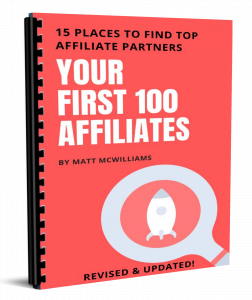 |
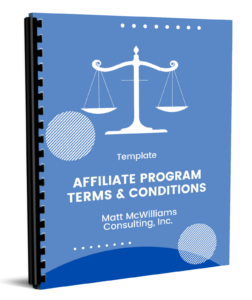 |
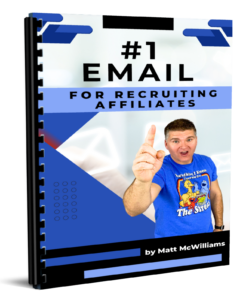 |
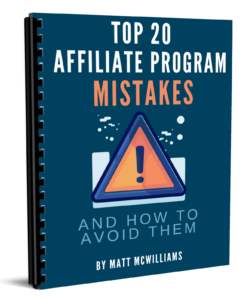 |
 |
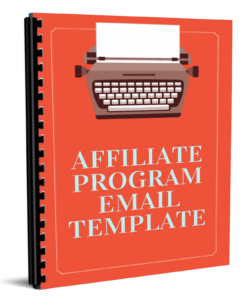 |
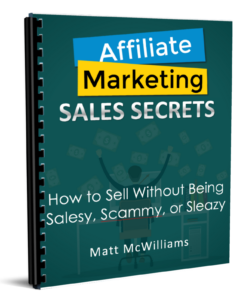 |
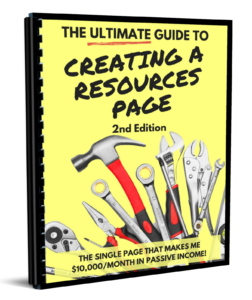 |
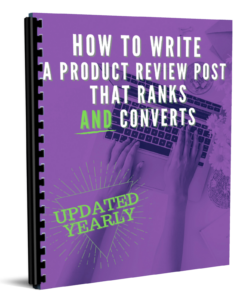 |

